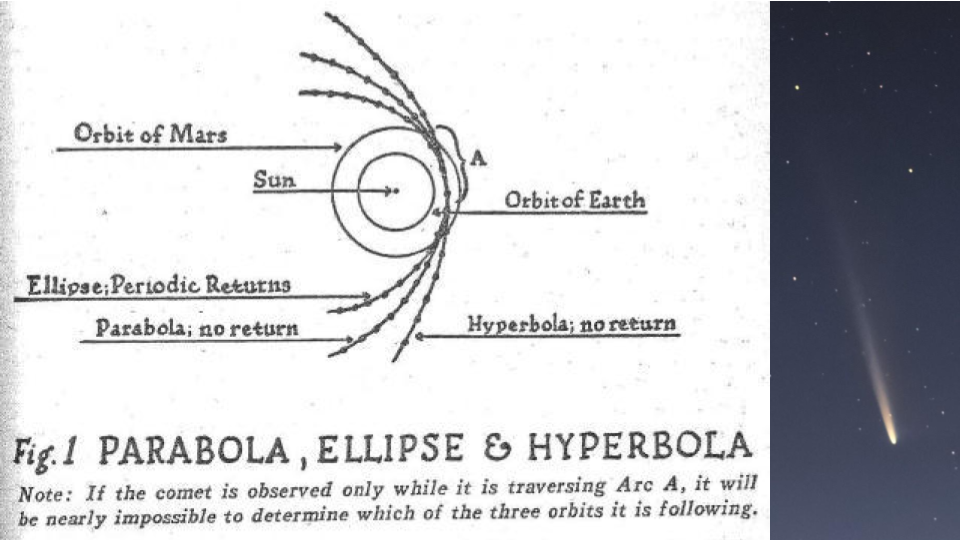
Growing up, I remember learning that comets could have elliptical, parabolic, or hyperbolic orbits. At the time, this was all about learning conic sections, and ellipticity of orbits, and it never really occurred to me that all those comets on escape orbits had to go somewhere…and similar comets and asteroids from other solar systems also had to go somewhere…and our Solar System counts as a possible destination.
In a 2021 paper led by Marshall Eubanks, researchers predict that around seven interstellar objects could pass through our solar system every year. Most have gone undetected because we don’t have the capacity to monitor the entire and determine orbits for everything we see.
Or at least we didn’t. With Rubin Observatory, we’ll be able to monitor the entire southern nighttime sky, and it was expected that with Rubin starting it’s survey, we’d start finding a regular parade of visiting interstellar objects.
But I3/ATLAS wasn’t one to wait. This high-speed icy object was discovered July 1, and made it into our last episode just under the wire. Since then, researchers have both taken new images with every possible telescope, and turned up pre-discovery images that had I3/ATLAS coincidently in the background of images taken for other purposes.
Our highest resolution images clearly show that I3/ATLAS is surrounded by a coma of sublimated gases, and it’s easy to call this a comet.
Now, there are those out there who would like to claim this is a visiting alien spacecraft, and use I3/ATLAS’s super annoying orbit as proof.
You see, I3/ATLAS is closest to the Sun and most likely to be doing interesting things when Earth is opposite from it on it’s own orbit around the Sun. Our local star is the worst wingman ever, and is going to make it impossible for us to get a good look at this scientific treasure from another solar system.
These things happen. The probability that the 3rd interstellar object ever discovered would be this terribly timed isn’t high, but it isn’t zero, and in our vast universe, someone has to pull the short straw, and this time it was us.
So far, we haven’t detected anything out of the ordinary in the chemical signature of I3/ATLAS. Observations by IRTF on July 12 saw colors consistent with D-type asteroids and comet nuclei, and when combined with Gemini Spectroscopy, the coma is consistent with the presence of water ice.
Looking at the object’s current motion, some researchers have speculated that I3/ATLAS could have come from the outer regions of our galaxy’s disk – the region we call the thick disk. If that’s the case, it could have come from a system significantly older than our own, but there are some strong caveats on that possibility. First of all, it assumes the object’s current trajectory hasn’t been bent and warped by myriad past interactions with other objects. We also need to remember there is a whole lot of galaxy between us and the thick disk, and if I3/ATLAS does have an un-altered trajectory, it could have originated anywhere between here and the thick disk, in another similarly aged star system. At the end of the day, this object will tell us about what is possible in our galaxy, but it won’t tell us about any specific place because we just don’t know for certain where, other than not here, that this object came from.
In the most likely case, I3/ATLAS won’t be out of the ordinary. Comets already come in a lot of different varieties and it doesn’t look weird…yet.
As it gets closer to the Sun and brighter, we’ll be able to get better data. In the most interesting of cases, we’ll be able to see complex molecules never seen in locally formed comets, or we’ll see atomic ratios that indicate it came from a solar system that was produced by a different set of supernovae than formed the stuff of our solar system. It’s possible we’ll find something super neat… but it’s also possible this object will confirm that comets are comets, and they come in a large variety, but that variety is pretty much the same everywhere. Time will tell. JWST observations are planned, and this is just the beginning of our research. I suspect we’ll be bringing you a whole series of stories over the next year… and I don’t expect any of them will include news of aliens or of technology other than our own.
